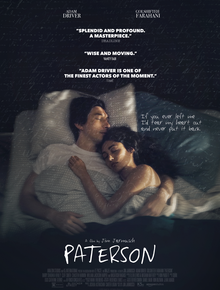Jim Jarmusch’s Paterson – The Power of Holding Back
When a filmmaker prefers to withhold key messages from viewers, it is usually a great way to engage the audience in interpretation, trying to decipher the undecipherable. After watching Jim Jarmusch’s latest poetic masterpiece Paterson, the power of revelation is contextualized within the poems that the main character Paterson writes during his long, routine rides as a bus driver. He takes the same route every day, meets a bunch of new –or familiar – faces and reminisces on his life and the chance encounters he makes. His life seems to be monotonous, redundant from a superficial standpoint. But digging deeper through analyzing the text a.k.a Paterson’s poems, the viewer is involved in the experience of the film, not as a passive bystander but more of a pinnacle of the action taking place onscreen.
Paterson is a man who holds back emotions. He’s a decent person, the only breadwinner of the house, living with his wife; a live-in artist who is probably slightly agoraphobic and somehow infected with the art-for-art gene which convinced her to stay home and wait for the inspiration to hit.
While she stays at home trying to figure out whether she wants to become a country singer, a cup cake maker or a painter; Paterson got out there making the art through his mundane route, driving the bus in the same route he goes through every single day, without showing irritability or complaint.
The audience wonders if Paterson is really alive or simply living. He doesn’t seem irritated by anything, not when his wife orders a guitar when apparently they struggle financially, not when Marvin the dog eats his entire poetry collection, or when he takes a bite off his wife’s pie which he clearly does not enjoy eating.
“Paterson” is not a movie to be watched once. The viewer slowly chews their way through it; and begins to realize things they haven’t had a chance to pay attention to throughout the first sitting. The power of Paterson lies in the poems. If the protagonist hides everything he actually feels behind a smile and a gesture of peace, composed and stiff body language, his poetry is a minefield for interpretations and symbolism.
Despite an accepting demeanor and overall acceptance for his wife’s eccentricities; Paterson writes “The Most Beautiful Match in the World” where he expresses his sobriety, his intention to burst into flame only to light the cigarette of the woman he loves, throwing a shadow probably over how meeting Laura changed his life forever, and how rocky their relationship is despite the casual calmness with which he accepts her detachment from the real-world and her artistic outbursts which usually lead to nothing. He describes their relationship as if she is the match and he the cigarette, and then changes roles when she becomes the cigarette and he becomes the match, unwittingly testing the boundaries of this relationship against the normal backdrop of their seemingly peaceful married life.
Jim Jarmusch is commonly known as a director who values his visual aesthetics, allowing time to take centre stage of his films. In “Dead Man”, the protagonist is a man dying over the course of 121 minutes and audiences learn through William’s Blake poetry how he gets to accept his destiny as a member of the dying; “Night on Earth” uses multiple narrative lines to express the way time passes with strangers interacting throughout unavoidable, non-connected conversations which peel off to reveal parts of the nightlife equal in intensity, opposing in nature; “The Limits of Control”, the lone wolf assassin explores his loneliness and trance-like routine through the contacts he meets throughout Spain.
In “Paterson”, a poem like “Glow” delves into the trapped feelings of fear that Paterson holds for his wife Laura. Her constant sleepiness into the day and avoidance of daily routines, make her appear through his words like an enormous, other-worldly creature, a vamp of sorts, and despite his love and awe of her, and his understanding of her semi-parasitism over his life, he is still afraid that one day she would “WAKE UP” and probably abandon him, or ditch him for another guy. Time is still centre stage of “Paterson” but Jarmusch replaces the vast settings and the anti-heroic journeys of “Only Lovers Left Alive”, “The Limits of Control” and “Dead Man” with the static expedition of a solitary man, harboring on stoicism and trapped within a thousand feelings barely expressed through his cryptic poetry. In “Pumpkin”, Paterson comes face-to-face with his fears; of abandonment and rejection by his beloved wife, shedding more light on the darkness that seeps underneath their quiet, apple-pie American life.
Symbolism runs in and out of Paterson’s life; through the mysterious subject of the twins that his wife mentions at the beginning of the film only to meet him all through the long work week; through the connection between daily life encounters and the little things his wife throws at him for inspiration in their tiny, sheltered home life.
Jim Jarmusch is famous for his visual poetry techniques, but in Paterson he creates a visual textbook that allows for multivariate angles through which a reader/viewer could analyze and interpret. “Paterson” is not simply a poetic movie about a bus driver/poet, but it is a tricky textbook, written for one careful reader, one digger and one careful newspaper hoarder who mastered the art of spotting the “odd one out.”

